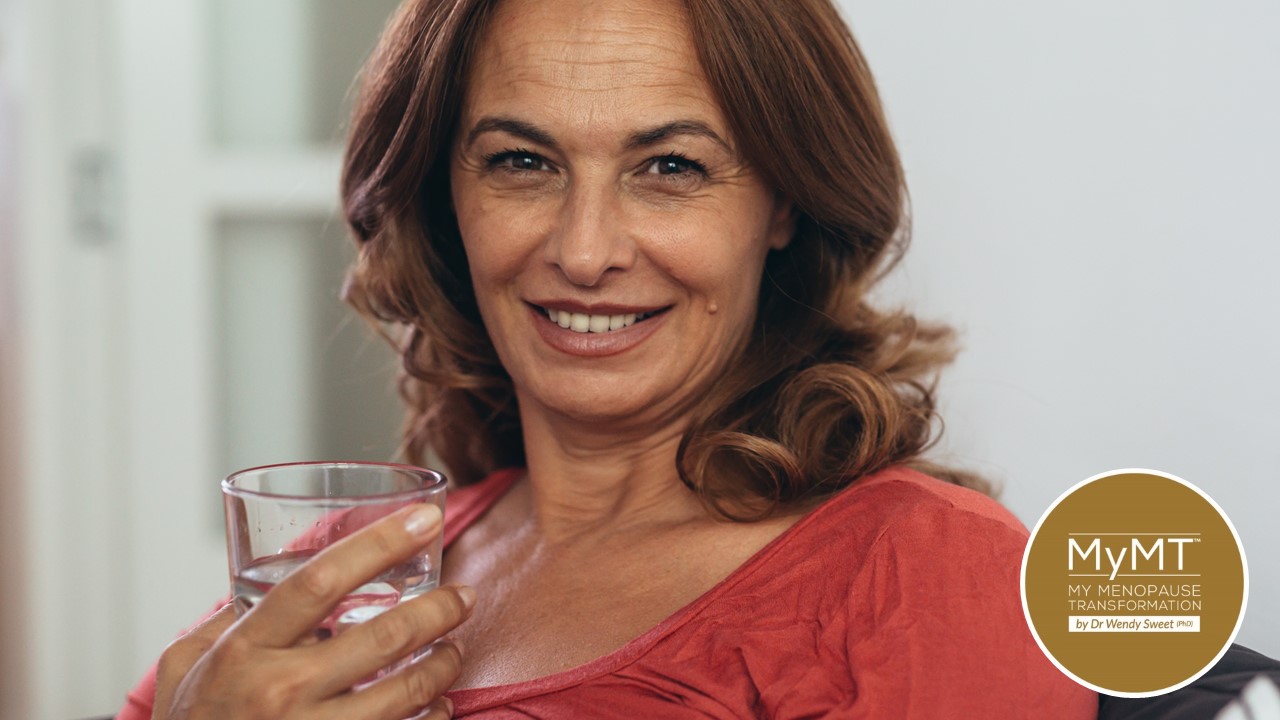If you’re feeling hotter as you move through your menopause transition, then I’m not surprised – especially if you live in the Northern Hemisphere at the moment. Canada and parts of the US Pacific Northwest are sweltering and 2020 was announced as the warmest on record from the EU earth observation service. My heart goes out to those of you wiping the sweat from your forehead continually – and you’re not even outside in the heat. In fact, those of you in the Southern Hemisphere and here in New Zealand are experiencing a cold, winter blast … and you may be still wiping the sweat from your forehead.
So, I have a question for you.
Are you drinking enough mineral enriched water?
Your water intake is essential to regulating your sodium-potassium balance in the body and if you are in post-menopause with high blood pressure, then you have to remember that the reduction of oestrogen as you age, affects your kidney regulation of water balance. If you feel swollen, bloated or you have aching muscles, then I know how you are feeling.
With the huge emphasis on other forms of fluid in our lives, (especially wine judging by the incredible response to last week’s article about wine and menopause), water gets forgotten. In a heatwave we may not be drinking enough and when it’s cold outside and a polar blast is ravaging over the lower parts of New Zealand and Australia, it’s hard to drink enough cold water – you tend to want hot drinks instead.
But water is essential for life … and it’s particularly essential to women in menopause and post-menopause.
“From the time that primeval species ventured from the oceans to live on land, a major key to survival has been prevention of dehydration. The critical adaptations cross an array of species, including man. Without water, humans can survive only for days. Water comprises from 75% body weight in infants to 55% in elderly and is essential for cellular homeostasis and life.” [Popkin, et al. 2010].
On my facebook feed today, up popped an image that I posted in February last year before the world turned to chaos. It’s a photo of where I used to fill my water bottles before heading out for a hike. When you walk through this small alpine village in Switzerland, you pass a number of ancient water troughs. The glacial water runs down off the towering mountains above and into the troughs in the village. At first I thought that these were for animals, but they aren’t. The locals drink this water and according to the World Health Organisation, this village has pristine water that is ranked high in its calcium and magnesium content.
“Some of the best quality water in Switzerland is sourced from this valley” mentioned Johanna who works at the UN in Geneva – I used to walk with her and her dogs. She told me about the high amounts of calcium in the water, which fascinated me – women in menopause and post-menopause need calcium and of course, magnesium … and not necessarily from supplements.
One litre of this water delivers around 520mg of calcium. That’s half of our total calcium intake of 1200mg per day. Drink 2 litres, as I did each day I was there and there is your calcium, done and dusted without a calcium supplement in sight.
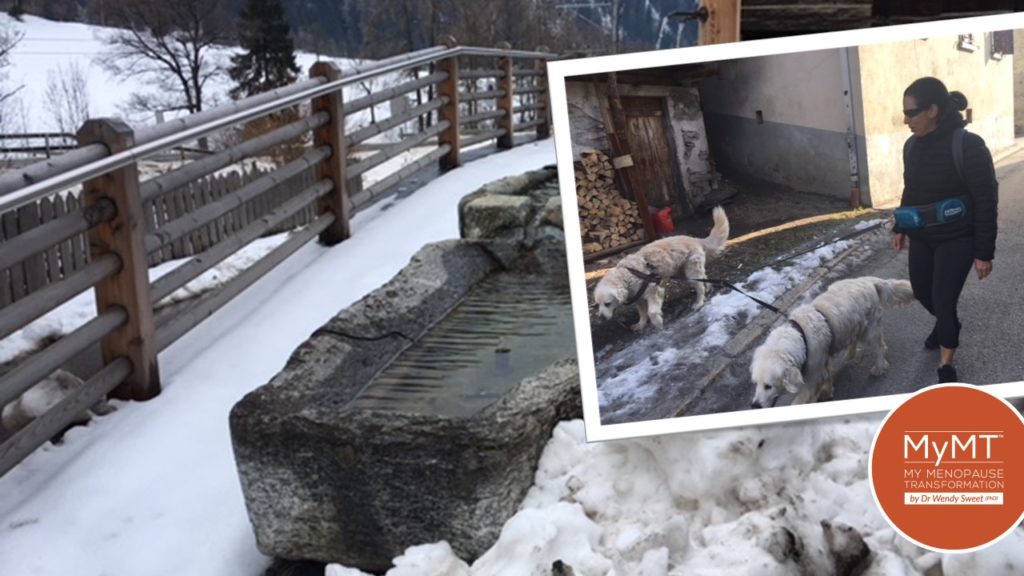
This is particularly good news for women in menopause or post-menopause. New research from the American Heart Association, shows that calcium supplements can be problematic for women in post-menopause. If all of our calcium is taken in supplements, then the body doesn’t absorb this type of calcium very well and this may lead to increased kidney stones and calcium plaques on our arteries.
For a generation of women convinced that we need lots of various supplements as we age, especially calcium supplements for improved bone health, then this is important information that we need to have – because if we need to be cautious about calcium in supplements, then we need to know how to source our 1200mg of calcium a day from food and water sources instead. I have all the lists for the minerals we need in the brand new MyMT™ Food Guides that I have as part of my 12 week coaching programmes.
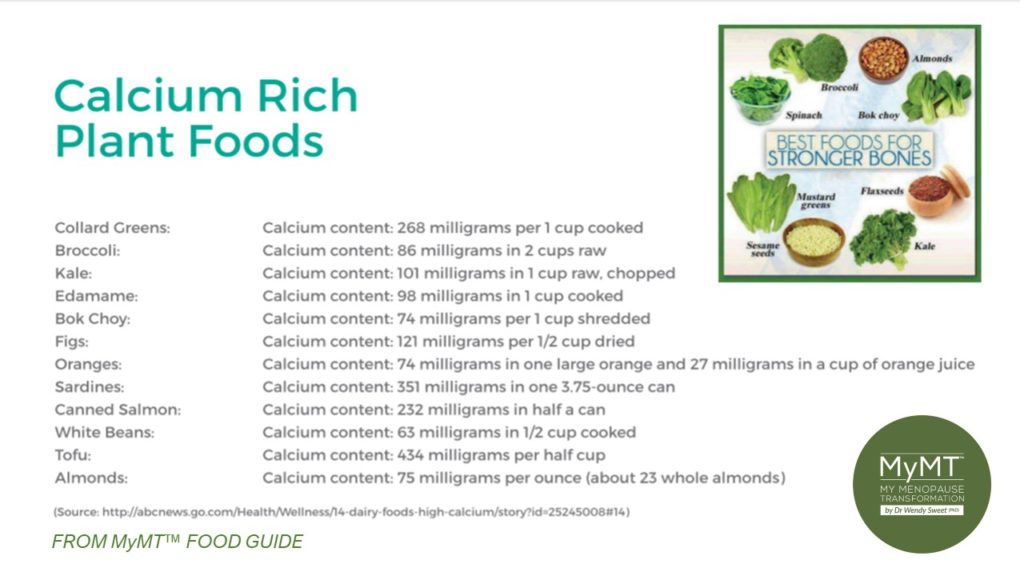
I never thought about my need for minerals or water when I went into peri-menopause. But with my head buried in my PhD and women’s healthy ageing research, I began to understand that one of the most important changes that occur as we lose oestrogen, is the increased constriction of our blood vessels (called vascular stiffness) and the numerous changes to our muscles and nerves too. All of these structures are affected by the loss of oestrogen and as such, we need to understand the nutrients, including vitamins and minerals, that help these organs to function better as we age.
Hypertension is a major risk factor for cardiovascular disease and is also the main factor for morbidity and mortality in postmenopausal women (Gillis et al, 2016). It is well know that the declining levels oestrogen and other ovarian hormones influences this risk and I talked about this in a number of articles. But in terms of our water intake, one of the mechanisms that has been proposed to explain hypertension (high blood pressure) in menopausal and post-menopausal women, is to do with the effects that declining oestrogen levels have on sodium and water retention. (Zhang et al, 2019). This is partly why our water intake matters. Every day you need 1.5 to 2 litres and if you are in a heat-wave or you are a regular exerciser, then focus on your intake. Doing this will help to reduce your hot flushes too.
My readings for my research took me on an incredible journey to better understand the role of specific minerals that help our nerves, blood vessels and heart to function as we move through menopause. When I studied the effect of low oestrogen on our physiology, metabolism and various organs such as nerves and muscles, this partly revealed why so many women end up with sore muscles, restless legs, cardiac palpitations and increased anxiety in menopause.
Getting certain minerals into us as we age is important – and calcium and magnesium are just two of these that we need to manage our intake of every day, because our body doesn’t make them. We need them from our diet and our water.
The minerals that matter include calcium, magnesium, potassium, phosphorous, sodium and chloride.
All these minerals are necessary for optimal heart, blood vessel and nerve function in a body that is losing oestrogen. For exercisers, then you may not know that your muscles require calcium to contract efficiently, hence your needs are greater for both calcium and water. Calcium is the ‘carrier’ of the electrical signal from the nerve endings into the muscle fibres.
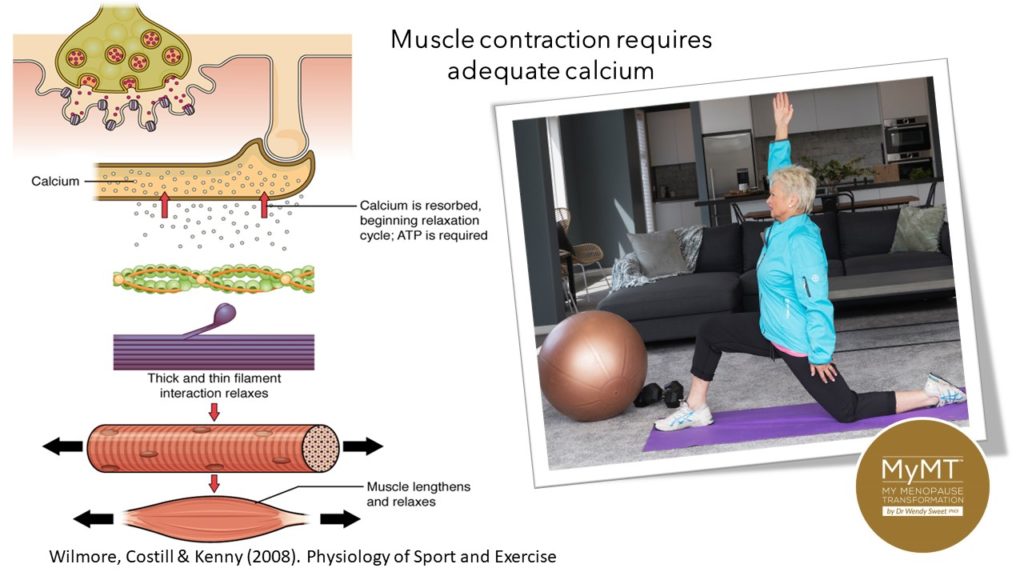
The type of water that you are drinking matters and it’s why, when women come on board with me, one small change I’ve been helping them to understand (apart from learning to sleep all night which is also crucial to reducing muscle soreness and improving other symptoms), is how to have a renewed focus on the quality and amount of their daily drinking water. Especially if they are doing a lot of exercise and/or experiencing hot flushes and night sweats – their own internal heat wave.
Hydration status is critical to the body’s process of temperature control. Body water loss through sweat is an important cooling mechanism in hot climates and in physical activity and many of you are sweating daily because of your hot flushes. If you are in post-menopause and still experiencing sweats (despite your HRT) then please come on board with me if you can – you are suffering needlessly but this additional sweating is to do with how your blood vessels change in post-menopause.
Sweat production is dependent upon environmental temperature and humidity, activity levels, type of clothing worn and of course, as many of us know. sweat production is also influenced by changing hormones. Whilst there hasn’t been research undertaken on how much water is lost in women via hot flushes and night sweats (or none that I ‘m aware of), in sport and exercise science research we know that water losses via skin (both insensible perspiration and sweating) can range from 0.3 L/h in sedentary conditions to 2.0 L/h in high activity in the heat. Intake requirements therefore, range from 2.5 to just over 3 L/d in adults under normal conditions, and can reach 6 L/d with high extremes of heat and activity, especially for those athletes competing in heat and humidity.
But even if you aren’t an athlete, then moving through menopause, has it’s own challenges with water and mineral regulation in the body. For those of you who are dehydrated and not getting enough calcium (and magnesium) into you, then your muscles can become more inflamed, especially if we aren’t sleeping all night. If women aren’t sleeping, then their muscles aren’t recovering and if they haven’t got their calcium [and magnesium] intake sorted, then they develop sore, aching muscles, restless legs and increased palpitations and anxiety too – don’t forget, your heart is a muscle as well and it is affected by lowering oestrogen levels too.
For our muscles to recover and function every day, calcium intake matters, as does water intake. When ex-teacher Kate sent me this gorgeous photo this week of her up in the Outer Hebrides and mentioned she was doing lots of hiking and swimming, I knew she had her symptoms (and water intake) sorted!
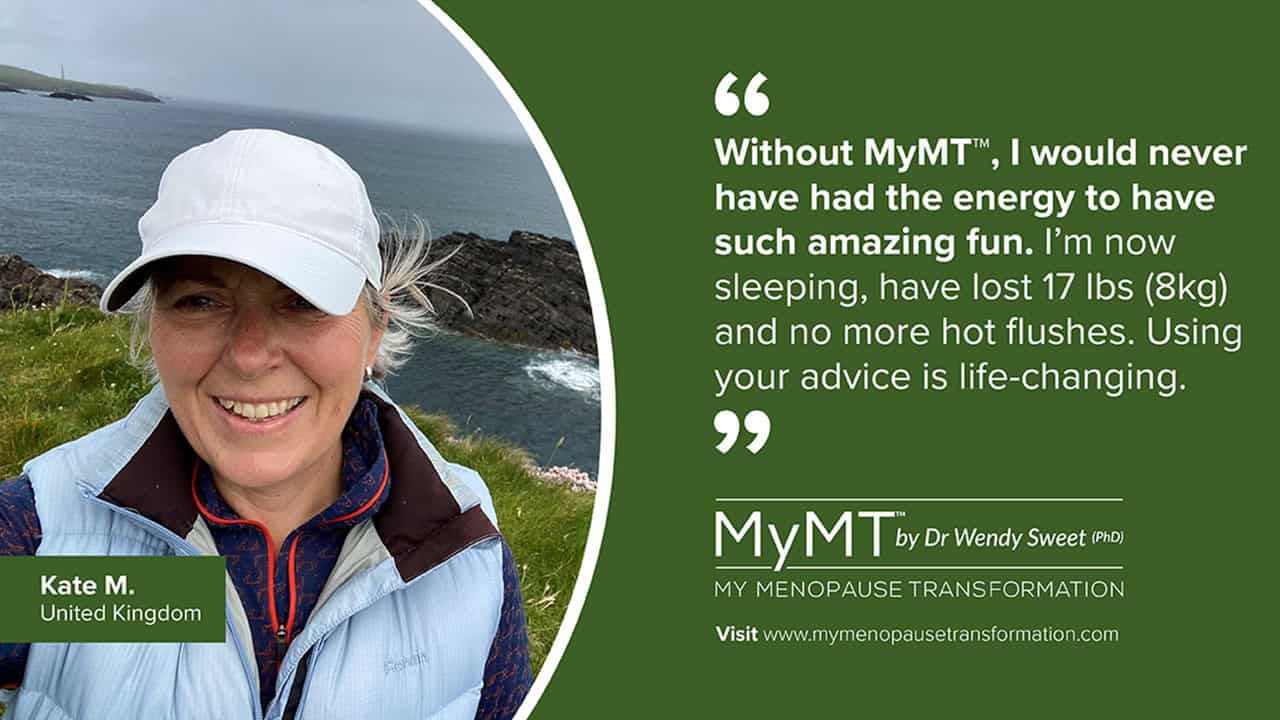
Over the past month, numerous women from around the world have joined me in the MyMT™ programmes. I’m so grateful that they have, because I want them to discover the powerful strategies that I’ve spent years researching to turn around our health, weight and symptoms in menopause and post-menopause naturally without the need for endless supplements and medications. One of the things I teach them is about getting back to basics with the type and timing of food and hydration, so that they reduce inflammation in their gut and liver and get the nutrients that their body needs as it transitions from producing oestrogen and progesterone to not producing oestrogen and progesterone. This is what the body is trying to achieve in menopause!
Drinking water that has fed from alpine regions and runs over rocks, means that the water is picking up all the minerals it can, hopefully without the additional pollution. These minerals are generally magnesium, calcium, phosphorus, potassium and other minor minerals. And yes, in our menopause transition, all these minerals matter to our symptoms and health as we move through this important life-stage.
For those of you in your post-menopause years (around 52 years and upward), I hope you have found your email telling you about my JULY post-menopause weight loss SALE. If not, then check your junk mail please or visit this link HERE. Women are already underway and I can’t wait for you to be as well.
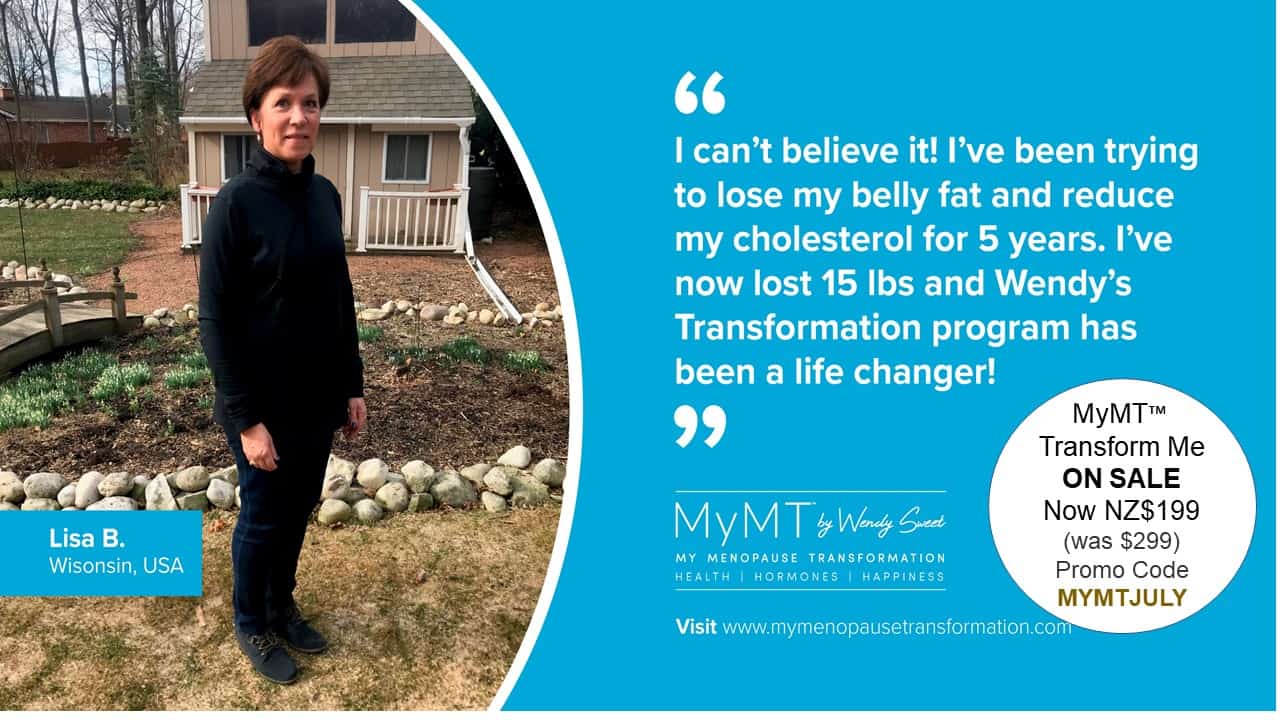
References:
Gillis, E. E. & Sullivan, J. C. (2016). Sex Differences in hypertension: recent advances. Hypertension 68, 1322–1327.
Maas, A. (2020). A woman’s heart. Why female heart health really matters. London: Octopus Publishing Group
Popkin, B. M., D’Anci, K. E., & Rosenberg, I. H. (2010). Water, hydration, and health. Nutrition reviews, 68(8), 439–458.
Kuo, I. Y., & Ehrlich, B. E. (2015). Signaling in muscle contraction. Cold Spring Harbor perspectives in biology, 7(2), a006023.
Wilmore, J., Costill, D. & Kenney, WL (2008). Physiology of Sport and Exercise. Champaign, Illinois: Human Kinetics.
Zhang, X., Ge, Y., Bukhari, AAS. et al. (2019). Estrogen negatively regulates the renal epithelial sodium channel (ENaC) by promoting Derlin-1 expression and AMPK activation. Exp Mol Med 51, 1–12.
